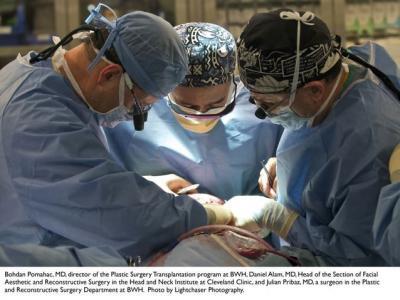In March 2011, a surgical team at Brigham and Women's Hospital (BWH) performed the first full face transplantation (FFT) in the United States and went on to complete a total of three FFTs this year. In an effort to advance the field of face transplantation, Dr. Bohdan Pomahac, Director of the Plastic Surgery Transplantation Program at BWH and lead surgeon in all three FFT procedures and colleagues document the novel processes involved in a successful face transplant program from screening candidates to the transplant procedure itself and the follow up management of the recipients. They describe the rigorous screening and consent process that each patient must pass, which includes evaluation by a team of physicians who determine whether the patient is physically and mentally prepared for the procedure through numerous clinical and psychological evaluations. Once a candidate is approved by the face transplant team and the Institutional Review Board at BWH, BWH physicians work closely with the New England Organ Bank (NEOB) to identify the criteria for suitable donors and the process for obtaining consent for this unique transplantation. Next, researchers outline the details of the surgeries with a focus on the multi-disciplinary collaborative efforts of an entire team of clinicians. Surgeons and staff coordinate their tasks while preparing the recipient and simultaneously retrieving the donor tissue within a limited time frame. The researchers describe the similarities and difference between each procedure, noting the various differences that occurred in the one FFT recipient who also concurrently received a bilateral hand transplant.
Writing in the New England Journal of Medicine, researchers evaluate FFT in the US and describe details of patient preparation, design and execution of the operation as well as unique immunosuppression protocol allowing for lowest long-term maintenance drug regimen. They also share details of the early functional outcomes and demonstrate FFT as a viable option in the treatment of severe facial deformities and injuries.
"Unlike conventional reconstruction, facial transplantation seeks to transform severely deformed features to a near-normal appearance and function that conventional reconstructive plastic surgical techniques cannot match," said lead author Dr. Bohdan Pomahac, Director of the Plastic Surgery Transplantation Program at BWH and lead surgeon in all three FFT procedures. "It truly is a life-giving procedure for these patients."

Bohdan Pomahac, M.D., Daniel Alam, M.D., and Julian Pribaz, M.D., during face transplantation surgery performed at Brigham and Women's Hospital. Photo: Brigham and Women's Hospital/Lightchaser Photography
Lastly, researchers explain the care of the recipient post-transplant. Following the surgery, physicians monitor and adjust immunosuppressants (anti-rejection medications) while methodically screening for any signs of organ rejection. The researchers discuss occurrences of single episodes of rejection in two patients, as well as describe other complications following surgery, like occurrence of infection. Pomahac and colleagues discuss how the transplanted tissue transformed and adapted to match the features of the recipient in each case.
"Our focus moving forward continues to be on monitoring and documenting the progress of patients who have undergone FFT, and refining the use of immunosuppressants, with the hope that one day patients will eventually need to take little or none," said Pomahac. We are also learning how brain reintegrates the new parts, and follow closely motor and sensory return. Important part of the study is also calculation of cost-effectiveness.






Comments